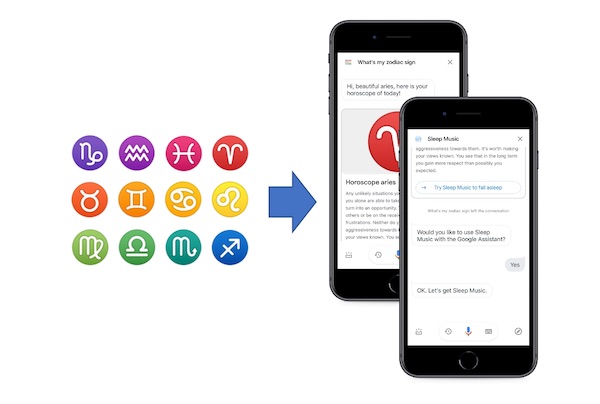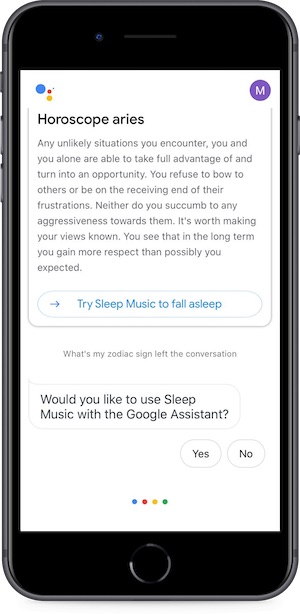How a Google Assistant Developer Solved the Voice App Discovery Problem and Then Launched a Service to Help Others

“What’s my zodiac sign” launched as an Action for Google Assistant about 18 months ago. In 2019, it racked up a total of about 8,000 sessions. This type of performance is not out of the ordinary. This year, the performance of What’s My Zodiac sign has been anything but ordinary. The voice app now has over one million sessions from 150,000 unique users and averages 6,000 daily active users (DAU).
Menno Zevenbergen, the creator of “What’s my zodiac sign,” is head of conversational at Greenhouse, a WPP company. With that kind of background, he is not exactly a novice to conversational design or marketing. However, Zevenbergen employed a few strategies that may be useful tips for even experienced voice app developers. It’s one thing to build an engaging voice experience. It’s something else to build a large audience on one of the leading voice app platforms. Voicebot interviewed Zevenbergen to learn more about the techniques behind the success of “What’s my zodiac sign” and learn more about the new voice app discovery service he recently launched.
The Objective Behind What’s My Zodiac Sign

Menno Zevenbergen, creator of “What’s my zodiac sign” and VoiceAppDiscovery.com
Zevenbergen’s objective was to create a voice app that people would use every day. He had previously worked on efforts through his role at Greenhouse to launch Donald Duck Magazine on Google Assistant in the Netherlands. That title quickly became the most popular Google Assistant Action in The Netherlands with over 100,000 monthly active users (MAU). It was unclear whether you could achieve significant success in building up Google Action DAUs or MAUs without a well-known brand behind the effort. He decided to focus on the daily horoscope and apply insights gained from his work on Donald Duck and numerous chatbot deployments along with some basic psychological theory.
Reading the Signs
From the beginning, Zevenbergen was thinking about both discovery and retention. The number one discovery strategy he focused on was the Google Action name. Instead of naming his Google Action simply “Zodiac Sign” or “Daily Horoscope,” he did some research. Google Trends and keyword search data suggested that a question starting with, “What’s my…,” was commonly employed in search when asking about horoscopes. He also tried several voice queries with Google Assistant and figured out that “What’s my horoscope,” “What’s my horoscope today,” and many other variants all resulted in a list offered by the Assistant for the user to choose from.
Google was reserving this intent to offer users a selection of different horoscope related Actions. That meant any Google Action with the term horoscope included in a question would go to a list of options and not directly to an Action unless there was a perfect match to the Action name. An example of this risk is the Google Action, “What’s my horoscope.” If you say, “Hey Google, what’s my horoscope,” the Assistant offers you several options with “What’s my zodiac sign” as the first suggestion. The “What’s my horoscope” Google Action isn’t even suggested in the first six titles. In order to access “What’s my horoscope”, you must say “Talk to,” or “Launch,” prior to the Google Action name. The Google Action “Daily Horoscope” has a similar challenge even when asking “What’s my daily horoscope.”
Finding Fortune in Discovery
By contrast, the term zodiac was not as common in search as horoscope but was still significant and it didn’t include the risk of Google hijacking the intent. Asking Google Assistant “What’s my zodiac sign” consistently invokes the Action directly. There is not a list of suggestions. The Action name also answers a specific question that users commonly ask in search and could be expected to also ask of the Google Assistant. Indeed, the Action answers this question. In addition, users tend to both stay with the Action experience for about 30 seconds and return again in the future. These are both signals that reinforce to Google Assistant’s algorithms that the Action answers the question and to the extent that implicit invocations are still being used by Google, is likely to help future users with a similar question.
Interestingly, if you search by text in Google Assistant for horoscope or zodiac, “What’s my zodiac sign,” may show up as an autocomplete but not in the search results. That seems like a missing opportunity for the Action in terms of optimization but probably doesn’t matter all that much. Voice assistant interactions typically use natural language and a one or two word keyword text search is not likely to happen all that often.
Zevenbergen’s strategy paid off. Not only was he getting direct hits on queries related to “What’s my zodiac sign?” but in February 2020 his Action also became the top result for the query “What’s my horoscope?” Every time that query was spoken to Google Assistant, “What’s my zodiac sign” was the first of three options offered on smart speakers and first of six options on smart displays. This discovery prompt from Google Assistant began a rapid acceleration of user acquisition.
A Future of Retention
Zevenbergen’s good fortune to rise to the top of the search results for “What’s my horoscope?” would not be wasted. He had already built user retention elements into his Google Action. First, Zevenbergen wanted to fulfill the intent of the user very efficiently. He had a goal of giving the horoscope as quickly as possible. For new users that simply required determining their birthday. Not only was there a target of delivering the full horoscope within 10 seconds, the Action tells new users that they will receive their horoscope within 10 seconds. It sets expectations and removes a potential concern about how much the user may be committing to with this particular voice experience.
Second, he found that shorter, more concise horoscopes were leading to more completed sessions. There may be an opportunity to convey many paragraphs worth of horoscope goodness but that’s often the opposite of what people want when interacting on a smart speaker. They want the facts. Ensuring users heard the entire horoscope before abandoning the session also gave him a captive audience that was still around when the Action offered to add “What’s my zodiac sign” to a routine or notification. “What’s my zodiac sign” is now getting about 5,000 opened notifications from Google Assistant each day. If you compare that to the DAUs for the Action you will conclude that nearly 85% of daily user sessions are driven by this single technique.
And, while he doesn’t have all of his 150,000 unique users listening every day his retention statistics today are impressive often getting over 40% of users one week returning for the next and even maintaining the vast majority of those into the following week. This allows “What’s my zodiac sign” to make the most of its positioning for discovery by making sure the first experience is likely to lead to repeat visits.
Leveraging Retention for New Discovery
 The techniques that lead to retention can also be used to drive discovery for other third-party voice experiences. For example, after the horoscope is delivered, Zevenbergen tested a call to action for another Google Assistant Action he created called “Sleep Music.” He found that 4-5% of those prompted with this offer converted. “Sleep Music” grew from zero to 2,100 users in just 30 days. Those results gave him the confidence that the audience for “What’s my zodiac sign” would be receptive to trying other Google Actions. He could certainly do that to drive audience growth for his own Google Actions but there was also an opening to offer this same opportunity to others.
The techniques that lead to retention can also be used to drive discovery for other third-party voice experiences. For example, after the horoscope is delivered, Zevenbergen tested a call to action for another Google Assistant Action he created called “Sleep Music.” He found that 4-5% of those prompted with this offer converted. “Sleep Music” grew from zero to 2,100 users in just 30 days. Those results gave him the confidence that the audience for “What’s my zodiac sign” would be receptive to trying other Google Actions. He could certainly do that to drive audience growth for his own Google Actions but there was also an opening to offer this same opportunity to others.
The result of this is Zevenbergen’s new venture, Voice App Discovery (You might notice a consistent theme in Zevenbergen’s naming process; Sleep Music and Voice App Discovery are also common search terms). Voice App Discovery’s top-level messaging is, “Get your voice app in front of 5000+ daily active users on the Google Assistant.” All of those daily horoscope users are now an audience that Zevenbergen can monetize by allowing others to promote there own voice apps.
You might think this type of promotion is not allowed in Google Assistant. It’s advertising after all. Well, if you read Voice Insider you already know that an update to Google Assistant’s policy means promotion is perfectly fine as long as it is not “deceptive or harmful.” Zevenbergen saw this (as did my guest on the Voicebot Podcast Episode 140) and was confident he could use the strength of his Google Assistant audience to drive revenue.
Building a Business from a Successful Voice App
There is a strain of thinking that subscription is the only way to monetize voice apps. That is not correct. For example, many Flash Briefings on Amazon Alexa actually have sponsors that help defray costs, and in some cases, drive profitable revenue. There is no reason (other than policy in the case of Alexa) that the same economic model cannot be applied to any voice app with an audience. Media companies have been building audiences and monetizing them for centuries. Google Assistant allows this model to be employed now as long as it doesn’t violate a few policy constraints.
Today, Voice App Discovery is open for business and selling access to its audience for $20 CPM. This is higher than you would pay for a mobile display ad or even a search ad right now but Zevenbergen stresses that his audience is highly targeted based on behavior. The entire audience uses Google Assistant. Advertising in mobile display networks to people that don’t use Google Assistant is a waste of your marketing investment. In other words, the return on marketing investment will be much higher as the impressions will go to consumers with a higher likelihood to convert to try another voice app.
Voice App Discovery does require a minimum purchase of 25,000 impressions. At $20 CPM that is a minimum of $500 to get started. When asked about the 25,000 impression minimum, Zevenbergen, who is used to running big campaigns for large brands, said that he wanted to ensure that his customers see meaningful uptick in their users. If you serve just 1,000 impressions a 4-5% conversion rate would result in 40-50 new users. That might be impressive on a return on advertising spend (ROAS) basis, but probably not very meaningful in the reported user numbers for the voice app publishers. With the 25,000 impression minimum, he is expecting his customers to see more easily discerned bumps of thousands of new users.
Voice App Discovery Should Have More Available Tools
The Discovery of voice apps is clearly a challenge. With that said, discovery is a challenge on every platform. Facebook app install ads were one technique that helped address this problem on mobile. Facebook had an audience of mobile app users and would promote the download of other apps to its users. It was a promotion entirely within the mobile user context. The model was very successful. Voice App Discovery is trying to replicate that for Google Assistant on a smaller scale. Given other data shared with Vociebot about cross-promotion of voice apps in the past, I suspect this will be a useful new tool in marketing voice apps to gain new users.
Follow @bretkinsella Follow @voicebotai
New Google Nest Audio Smart Speaker and Other Devices Debut in Half-Hour Hardware Blitz








